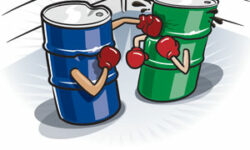TestOil, the industry leader in lubricant analysis, offers lubricant compatibility testing, which can help predict if mixing two lubricants might result in operational issues including: excessive foaming, formation of precipitates or deposits, and loss of key performance characteristics such as water separability.
This analysis can predict whether key physical and chemical performance properties of the lubricants will be compromised by mixing--thus potentially avoiding lubricant incompatibility-related equipment failure. Reasons for compatibility analysis include:
- To account for the fact that equivalent or comparable lubricants are not the same as compatible lubricants
- To ensure that key physical and chemical performance properties of the lubricants will not be compromised by mixing the lubricants
- To protect the life and performance of the lubricant and the equipment by avoiding lubricant incompatibility-related failure
TestOil employs ASTM D 7155 “Standard Practice for Evaluating Compatibility of Mixtures of Turbine Lubricating Oils” as the guideline for compatibility testing. If test results show signs of minor incompatibility, users need to consider the potential impact, i.e. a decreased ability to resist oxidation resulting in reduced lubricant life and increased cost.
TestOil’s Senior Technical Advisor Evan Zabawski said, “The unwanted effects from mixing lubricants can be significant. The lubricants can react and form jelly-like substances, cause seals to swell, or their additives can reduce each other’s effectiveness. The potential is there to bring down an entire piece of equipment often without any warning.”
TestOil’s Analytical Services Manager Monika Malcolm said “The most commonly encountered operational issues resulting from lubricant incompatibility include the loss of the ability to separate out water and foaming issues; although it may not be obvious to the end user that the root cause of the foaming or failing demulsibility is lubricant incompatibility.”
TestOil’s lubricant compatibility testing is both proactive and reactive. It can provide information to companies that are considering making a major lubricant switch and it can also provide valuable information that may prevent equipment failure after lubricants have been accidentally mixed.
Although TestOil provides comprehensive compatibility testing, users may be able to get some information from their lubricant supplier first—this is especially likely if the two lubricants are both made by the same manufacturer.
TestOil President Mary Messuti said, “We have been providing valuable compatibility testing for many years. The tests we offer, such as this one, help ensure our customers have the information they need to keep their operations up and running with no unplanned downtime.”
While, lubricant compatibility testing cannot guarantee compatibility, it can predict compatibility. For more information visit: https://testoil.com/services/lubricant-compatibility-analysis/
With more than 30 years of experience in the oil analysis industry, TestOil focuses exclusively on assisting industrial facilities with reducing maintenance costs and avoiding unexpected downtime through oil analysis program implementation. As industry experts in diagnosing oil-related issues in equipment such as turbines, hydraulics, gearboxes, pumps, compressors and diesel generators, TestOil provides customers with a guarantee of same-day turnaround on all routine testing. With in-house, certified training professionals, TestOil offers lubrication and oil analysis training, private onsite training, certification training and exams, and educational webinars. For more information on partnering with TestOil on oil analysis programs or training opportunities visit www.testoil.com.




